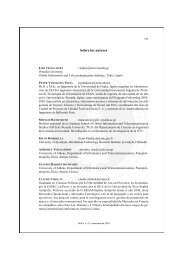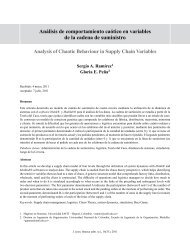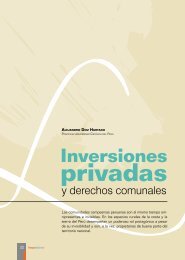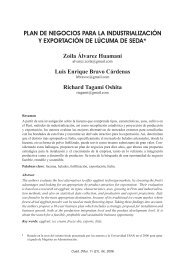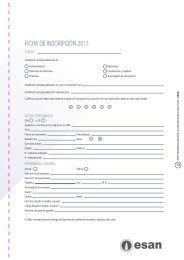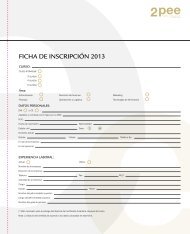re-engineering Agriculture For enhanced Performance ... - SciELO
re-engineering Agriculture For enhanced Performance ... - SciELO
re-engineering Agriculture For enhanced Performance ... - SciELO
You also want an ePaper? Increase the reach of your titles
YUMPU automatically turns print PDFs into web optimized ePapers that Google loves.
Re-Engineering Agricultu<strong>re</strong> <strong>For</strong> Enhanced<strong>Performance</strong> through Financing*Restructurando la agricultura para aumento de <strong>re</strong>ndimientoa través del financiamientoTaiwo Mafimisebi 1Adegboyega Oguntade 2Ojuotimi Mafimisebi 3Received date: June 30, 2010Accepted date: August 20, 2010AbstractInsufficient institutional c<strong>re</strong>dit is a major contributor to the persistent poor performance of the Nigerian agricultural sector. Toencourage financial institutions to inc<strong>re</strong>ase lending to the sector, a partial c<strong>re</strong>dit guarantee scheme was instituted. The schemecommenced operations in 1978 with an authorized capital of N 100.00 million, subscribed to 60% and 40% by the FederalGovernment of Nigeria and the Central Bank of Nigeria, <strong>re</strong>spectively. This paper p<strong>re</strong>sents an appraisal of the scheme. The<strong>re</strong>sults <strong>re</strong>vealed that the<strong>re</strong> has been continuous growth in paid-up sha<strong>re</strong> capital, total fund <strong>re</strong>sources, maximum amount ofloan obtainable by farmers, number and value of loans guaranteed, volume and value of loans fully <strong>re</strong>paid and volume andvalue of default claims settled. The<strong>re</strong> was a long-run convergence between the number and volume of guaranteed loans andthe agricultural GDP. This finding indicates the need to expand the quantum of funds available for guaranteeing agriculturalloans to inc<strong>re</strong>ase performance of the agricultural sector in the long run. This step is justified by the strategic role of agricultu<strong>re</strong>in the Nigerian economy in terms of food and fiber production, job c<strong>re</strong>ation, income generation, poverty <strong>re</strong>duction andeconomic stability.Keywords: Agricultural finance, c<strong>re</strong>dit guarantee, smallholders* The authors wish to gratefully acknowledge The World Bank for their financial support to deliver a first <strong>re</strong>port on this studyin its confe<strong>re</strong>nce on «Partial C<strong>re</strong>dit Guarantees: Principles and Practice», which took place in The World Bank Main Building,Washington DC, March 13 th – 14 th , 2008.1. Ph. D. in Agricultural Marketing/Agribusiness Management, Department of Agricultural Economics & Extension, The FederalUniversity of Technology, Aku<strong>re</strong>, Nigeria 2. Ph. D. in Agricultural Production/Agricultural Marketing, Department of Agricultural Economics & Extension, The FederalUniversity of Technology, Aku<strong>re</strong>, Nigeria, 3. M. Sc. in Agricultural Finance/Food Safety Economics, Department of Agricultural Economics, University of Ibadan, Nigeria.J. econ. finance adm. sci., 15(29), 2010
36 Journal of Economics, Finance and Administrative ScienceDecember 2010ResumenEl insuficiente crédito institucional es el mayor contribuyente al constante bajo <strong>re</strong>ndimiento del sector agrícola en Nigeria.Para alentar a las instituciones financieras a que aumenten el préstamo en el sector, se ha instituido un esquema de garantíade crédito parcial. Este esquema inició sus operaciones en 1978 con un capital autorizado de N100.00 millones, suscritos en60 % y 40 % por el Gobierno Federal de Nigeria y el Banco Central de Nigeria <strong>re</strong>spectivamente. Este estudio p<strong>re</strong>senta unaap<strong>re</strong>ciación de ese esquema. Los <strong>re</strong>sultados <strong>re</strong>velan que se ha dado un c<strong>re</strong>cimiento sostenido en el capital compartido pagado,total de <strong>re</strong>cursos del fondo, el monto máximo de préstamo obtenible por los agriculto<strong>re</strong>s, número y valor de los préstamosgarantizados, volumen y valor de los préstamos totalmente pagados y el volumen y valor de los <strong>re</strong>clamos por mora <strong>re</strong>sueltos.Se observó una gran cor<strong>re</strong>lación ent<strong>re</strong> el número y el volumen de préstamos garantizados y el PBI agrícola. Este <strong>re</strong>sultadoindica la necesidad de aumentar la cuantía de los fondos disponibles que garanticen los préstamos agrícolas para aumentar el<strong>re</strong>ndimiento del sector agricultura en el largo plazo. Este paso está justificado por el papel estratégico de la agricultura en laeconomía nigeriana en términos de producción de comida y fibra, c<strong>re</strong>ación de trabajo, generación de ing<strong>re</strong>sos, <strong>re</strong>ducción dela pob<strong>re</strong>za y la estabilidad económica.Palabras claves: Finanza agrícola, crédito garantizado, pequeños agriculto<strong>re</strong>sJ. econ. finance adm. sci., 15(29), 2010
Vol. 15, Nº 29Mafimisebi, Oguntade & Mafimisebi: Re-Engineering Agricultu<strong>re</strong> for Enhanced <strong>Performance</strong> 37INTRODUCTIONAgricultu<strong>re</strong> is still a dominant sector of the Nigerianeconomy. From the early 1950s to the early 1970s,the sector was a source of employment to about 80%of the labour force (World Bank, 1993; Upton, 1997).Agricultu<strong>re</strong> generated fo<strong>re</strong>ign exchange earnings usedin financing development projects in other sectors.Abundant and affordable food emanated from agricultu<strong>re</strong>for both domestic consumption and export duringthis period. This ensu<strong>re</strong>d a highly stable economy witha low rate of inflation (Nigerian Institute of Social &Economic Research (NISER), 2003).However, starting from the early 1970s when Nigeriabegan to export crude oil, the importance of agricultu<strong>re</strong>began to wane. Attention virtually shifted to theoil sector, which prog<strong>re</strong>ssively accounted for the bulkof fo<strong>re</strong>ign exchange earnings. As a <strong>re</strong>sult of inflow of«petrol dollars», Nigeria inc<strong>re</strong>asingly <strong>re</strong>lied on importationof food and agricultural raw materials instead ofinvesting in and st<strong>re</strong>ngthening the agricultural sector.This marks the decline of this sector as an engine ofeconomic growth. The <strong>re</strong>ason given was that <strong>re</strong>turnsfrom agricultu<strong>re</strong> we<strong>re</strong> far lower compa<strong>re</strong>d to other sectors(NISER, 2003). In spite of the underfunding, whichmakes Nigerian agricultu<strong>re</strong> largely traditional, subsistentand very low in the use of productivity-boostingtechnologies, it <strong>re</strong>mains an important economic drivercontributing about 42% to the nation’s GDP (Njoku,2010). About 70.3% of the rural and 34.8% of theurban poor a<strong>re</strong> engaged in di<strong>re</strong>ct, on-farm agriculturalproduction (NBS, 2006). The overriding importance ofagricultu<strong>re</strong> to the Nigerian economy is <strong>re</strong>vealed by thefact that despite oil and gas accounting for over 80%of the nation’s <strong>re</strong>venue, the contribution of this sectorto the GDP is only 23% (Njoku, 2010). Agriculturalloans we<strong>re</strong> <strong>re</strong>garded as low-yielding, high-risk loanswith towering administrative costs and consequentlyunattractive to grant (Coster, 1998). The problem ofunder-funding of the agricultural sector continued toaggravate to the extent that by the late 1970s, Nigeriahad become a net importer of many of the major fooditems it was exporting befo<strong>re</strong>. Thus, the oil boom of thelate 1970s brought in its wake the agricultural doom,which Nigeria has been battling to <strong>re</strong>verse in the lastth<strong>re</strong>e decades (Mafimisebi et al., 2008). The unbridledimportation of goods, especially food commodities andits attendant demand on the country’s fo<strong>re</strong>ign account,also placed the balance of payment in a p<strong>re</strong>cariousposition (NISER, 2003).The poor performance of the agricultural sector,which was first noticed about th<strong>re</strong>e decades ago,worsened through inadequate capital investment thatculminated in the vicious circle of low farm size, lowuptake of productivity-boosting technologies, lowoutput, low income and low farm size (Mafimisebi,et al., 2006, 2008). This magnified the p<strong>re</strong>valence ofsmall-scale farmers, <strong>re</strong>garded as highly unorganizedand poor in <strong>re</strong>source endowment and managerialskills (Akinwunmi, 1999). To <strong>re</strong>medy the problem ofpersistent low performance of the agricultural sector,the need for capital injection into agricultu<strong>re</strong> becameobvious (Olayemi, 1999; Udoh et al., 2002; Mafimisebiet al., 2006, 2008).In <strong>re</strong>cognition of the indispensable role of c<strong>re</strong>dit inengendering the development of Nigerian agricultu<strong>re</strong>,the government established the Nigerian AgriculturalCo-operative Bank (NACB) in 1973, which in 2003became the Nigerian Agricultural C<strong>re</strong>dit and RuralDevelopment Bank (NACRDB). Within a couple ofyears, the institution was burdened with very poor loan<strong>re</strong>covery rate (Kabir, 1985; Balogun & Otu, 1991; Dittoh,1992; Coster, 1998; George, 2002). Further effortstargeted at providing institutional c<strong>re</strong>dit for agriculturalpurposes and bridging the c<strong>re</strong>dit gap included mandatingcommercial banks to open branches in rural a<strong>re</strong>asfor easy and <strong>enhanced</strong> access to c<strong>re</strong>dit by farmers. Inaddition to this, commercial and merchant banks we<strong>re</strong>also mandated by the Central Bank of Nigeria (CBN) tocommit 15% and 8% <strong>re</strong>spectively of their loan portfoliosto agricultu<strong>re</strong>. Despite these laudable and potentiallyworkable policies, availability of institutional c<strong>re</strong>dit tofarmers <strong>re</strong>mained a mirage. The major <strong>re</strong>ason for thiscircumstance was the high default rate of agriculturalloans occasioned by low <strong>re</strong>turns compa<strong>re</strong>d with othersectors. The problem g<strong>re</strong>w to such an alarming dimensionthat many commercial banks deliberately <strong>re</strong>fused toJ. econ. finance adm. sci., 15(29), 2010
Vol. 15, Nº 29Mafimisebi, Oguntade & Mafimisebi: Re-Engineering Agricultu<strong>re</strong> for Enhanced <strong>Performance</strong> 39• Federal Government <strong>re</strong>cur<strong>re</strong>nt budget on theagricultural sector (FGRECBA);• Federal Government capital budget on the agriculturalsector (FGCAPBA);• Total volume of loans to the agricultural sector bycommercial and merchant banks (TVLACMB);• Total number of loans guaranteed by theACGSF (TNLGUAD);• Total value of loans guaranteed by the ACGSF(TVLGUAD);• Lending rate to the agricultural sector(LENRAGS in %);• Food importation bill (FOODIMB);• Cumulative number of fully <strong>re</strong>paid loans sinceScheme’s inception (CNFRLSI); and• Cumulative value of fully <strong>re</strong>paid loans sinceScheme’s inception (CVFRLSI).As a first step, the graphs of the key time series we<strong>re</strong>plotted to get a visual <strong>re</strong>p<strong>re</strong>sentation of the movementof the series over time. Owing to information from thegrowing literatu<strong>re</strong> on the characteristics of time-seriesdata especially that <strong>re</strong>lating to non-stationarity, whichleads to spurious <strong>re</strong>g<strong>re</strong>ssion estimates, we first investigatedthe order of stationarity (or econometric integration)using the Dickey Fuller (DF) and the AugmentedDickey Fuller (ADF) class of unit roots test as done byMafimisebi (2002a, 2007, 2008). The DF test is appliedto the <strong>re</strong>g<strong>re</strong>ssion of the form below.ΔP it= β 1+ β 2t+ δP it–1+ l it(4)Δ = first diffe<strong>re</strong>nce operatorP it= variable which series is being investigated forstationarityt = time or t<strong>re</strong>nd variableThe null hypothesis that δ = 0 implies existence of aunit root in P itor that the time series is non-stationary.The number of lagged diffe<strong>re</strong>nce terms in equation 4was inc<strong>re</strong>ased. The DF test is, in this particular case,called the ADF test and equation 4 modifies toΔP it= β 1+ β 2t+ δP it–1+ α 1 Σ ΔP it – 1 + l itmt =1(5)The null hypothesis of a unit root or non-stationarityis still that δ = 0. The critical values a<strong>re</strong> as tabulated byDickey and Fuller (1979), Engle and Yoo (1987) andMackinnon (1990).When a series was found to be non-stationary, itwas first-diffe<strong>re</strong>nced and the ADF test was <strong>re</strong>peated.The time series for all the agricultural c<strong>re</strong>dit-<strong>re</strong>latedvariables included in this study we<strong>re</strong> investigated fortheir order of integration. The maximum number of lagsused in the stationarity test was six (6) and the optimallag for each time-series was selected using the AkaikeInformation Criterion (AIC).Two or mo<strong>re</strong> variables a<strong>re</strong> said to be co- integratedif each is individually non-stationary but the<strong>re</strong> existsa linear combination of the variables that is stationary.Other attributes of co-integration a<strong>re</strong> as shown in Engleand Yoo (1987) and in Silvapulle and Jarasuriya (1994).After the stationarity test, the analysis proceeded bytesting for co-integration between time-series of agriculturalc<strong>re</strong>dit-<strong>re</strong>lated variables that exhibited stationarityof same order.<strong>For</strong> the multiple co-integration test, the maximumlikelihood procedu<strong>re</strong> for co-integration, propoundedby Johansen (1988), Johansen and Juselius (1990,1992) and Juselius (2006), was utilized. Adopting aone-step vector auto-<strong>re</strong>g<strong>re</strong>ssion (VAR) method avoidsthe simultaneity problem characteristic of the Engleand Granger procedu<strong>re</strong> (Baulch, 1995) and allowshypothesis testing on the co-integration vector, r. Themaximum likelihood procedu<strong>re</strong> <strong>re</strong>lies on the <strong>re</strong>lationshipbetween the rank of a matrix and its characteristicroots. The Johansen’s maximal Eigen value and tracetests detect the number of co-integrating vectors thatexists between two or mo<strong>re</strong> time-series that a<strong>re</strong> econometricallyintegrated. The two variable systems we<strong>re</strong>modelled as a VAR as follows:k – 1ΔXt = μ t + Σ Γ i∆X t – 1+ πX t – k+ε ti =1whe<strong>re</strong>:(6)X tis an n x 1 vector containing the series of inte<strong>re</strong>st(time-series of agricultural c<strong>re</strong>dit-<strong>re</strong>lated variables)J. econ. finance adm. sci., 15(29), 2010
40 Journal of Economics, Finance and Administrative ScienceDecember 2010Γ and π a<strong>re</strong> matrices of parametersk = number of lags and should be adequately largeenough to captu<strong>re</strong> the short-run dynamics of the underlyingVAR and produce normally distributed whitenoise <strong>re</strong>siduals.ε t= vector of errors assumed to be white noise.RESULTS AND DISCUSIONStructu<strong>re</strong>, Organization and Mandateof the SchemeThe Nigerian ACGSF (henceforth ‘’the Scheme’’ or‘’the Fund’’) was set up in 1977. Its purpose was toserve as an inducement to banks to inc<strong>re</strong>ase and sustainlending to agricultu<strong>re</strong>. Under the Scheme, bank loans tofarmers a<strong>re</strong> guaranteed 75% against default. Thus, theScheme is a partial c<strong>re</strong>dit guarantee type and largely asubsidization program. When a borrower defaults, theCBN, the Managing Agent for the Scheme, <strong>re</strong>mits to theparticipating lending bank (PLB) 75% of the amount indefault, net of any amount <strong>re</strong>alized by the bank from thesecurity pledged (whe<strong>re</strong> applicable) by the farmer. TheBoard of Di<strong>re</strong>ctors <strong>re</strong>sponsible for managing the Schemedoes this after ca<strong>re</strong>ful verification and approval. Verifieddefaults a<strong>re</strong> settled by the CBN from a fund set up forthe purpose. At the commencement of operations by theScheme on April 3 rd , 1978, the authorized capital of theFund was N100 million, subscribed to 60% and 40%by the FGN and CBN, <strong>re</strong>spectively. The proportion ofthe authorized capital paid up as at the time operationscommenced was N 85.5 million.<strong>For</strong> the purpose of administering the Scheme, thecountry was divided into four zones. Zoning and theuse of the branch/desk offices of the NACB as loan applicationform collection and submission cent<strong>re</strong>s allow<strong>re</strong>asonable access to Scheme’s operations by farmers.Since the Fund is <strong>re</strong>sident in the CBN, the<strong>re</strong> a<strong>re</strong> noseparate administrative structu<strong>re</strong>s needed for it to function.This is probably made possible by the fact that thePLBs have institutionalized procedu<strong>re</strong>s and mechanismsof <strong>re</strong>gularly meeting with the authorities of the CBN forpurposes other than that <strong>re</strong>lating to Fund administration.This has made the Scheme less costly to run in terms ofoverhead compa<strong>re</strong>d with other government-sponso<strong>re</strong>dprograms. Up to December 1986, when Nigeria adoptedan economy-wide <strong>re</strong>form tagged Structural AdjustmentProgramme (SAP), loans to agricultu<strong>re</strong> by PLBs we<strong>re</strong>granted at concessionary inte<strong>re</strong>st rates.The activities being funded under the Scheme havewitnessed little or no modifications since inception andthey cover all sub-sectors of Nigerian agricultu<strong>re</strong>.The Nigerian C<strong>re</strong>dit Guarantee Scheme –A performance appraisalThe findings from the empirical analyses a<strong>re</strong> discussedas follows.a) Paid-up sha<strong>re</strong> capital and total asset of the SchemeThe N 85.5 million paid-up capital at commencementof operations in April 1978 inc<strong>re</strong>ased to N147.4 million ten years later as a <strong>re</strong>sult of investingit in government securities. The exponentialgrowth rate analysis <strong>re</strong>vealed that this <strong>re</strong>p<strong>re</strong>sentsan annual growth rate of about 7.24%. Ten yearslater (December 1998), the Scheme’s paid-up capitalhad inc<strong>re</strong>ased to N 1.78 billion, which impliedannual growth rate of 18.34%. By December 31 st ,2005, the paid-up capital stood at N 2.5 billion. Theannual growth rate in this seven-year period (1998-2005) was 5.06%. The high growth rate betweenthe period 1988 and 1998 is probably to compensatefor the high rate of inflation witnessed during thisperiod. The mean annual growth rate of paid-upsha<strong>re</strong> capital for the period <strong>re</strong>viewed (1978-2005)is about 10.21%. Of the N 2.5 billion paid-up sha<strong>re</strong>capital as at end-December 2005, the CBN had fullypaid up its sha<strong>re</strong> of N 1.33 billion. The FGN wasyet to make a full payment of its sha<strong>re</strong> subscriptionand has consistently defaulted in this <strong>re</strong>spect sinceinception of the Scheme. The total <strong>re</strong>sources of theFund as at end-December 2004 stood at N 4.4 billion.By 2005, total Fund <strong>re</strong>sources had inc<strong>re</strong>asedto N 4.7 billion.J. econ. finance adm. sci., 15(29), 2010
42 Journal of Economics, Finance and Administrative ScienceDecember 2010to small-scale farmers. This accounted for about65.5% (or N 2.03 billion). This implies that bankswe<strong>re</strong> persuaded by the Scheme to lend to small-scalefarmers, especially those borrowing N 20,000and below, without demanding tangible securities.In terms of categories of borrowers, at the end of1988, 96.1% of total guaranteed loans went to individuals,1.3% went to co-operative societies and2.3% went to corporate bodies. Looking at valueof guaranteed loans <strong>re</strong>ceived, individuals, co-operativesand corporate bodies <strong>re</strong>ceived 37.5%, 1.6 %and 60.9% <strong>re</strong>spectively. In 1998, and particularlyin the last th<strong>re</strong>e years cove<strong>re</strong>d by this <strong>re</strong>view, the<strong>re</strong>has been no change in this distribution pattern. Fo<strong>re</strong>xample, in 2004 individual borrowers dominatedthe Scheme with the number and values of loansguaranteed amounting to 34,912 and 2.0 billion <strong>re</strong>p<strong>re</strong>senting99.6% and 96.5% of the total, <strong>re</strong>spectively.In 2005, individual borrowers accounted for99.0% and 97.5% <strong>re</strong>spectively of the total volumeand value of loans guaranteed. Co-operative societiesaccounted for 0.3% and 1.0%, while corporatebodies took the balance.Considering term structu<strong>re</strong> of loans, short-termloans of less than th<strong>re</strong>e years duration continue todominate the lending procedu<strong>re</strong> under the Schemefrom inception. At the end of December 1988, suchloans accounted for 97% of total loans guaranteed.Medium term loans that matu<strong>re</strong>d between th<strong>re</strong>e andfive years constituted 2.8%, and those falling duein over five years, took 0.2%. This is comparableto the situation in 1987 when short, medium andlong-term loans accounted for 96.5%, 3.1% and0.4% <strong>re</strong>spectively of the total number of loans guaranteed.This distribution pattern has not changedconsiderably at the end of December 1998 and inthe last th<strong>re</strong>e years of the Scheme, for which theaverage distribution was 94.6%, 4.4% and 1.0%,<strong>re</strong>spectively.f) Econometric integration and co-integrationFigu<strong>re</strong>s 1 and 2 a<strong>re</strong> the plots of the key time series,namely: loan volume, <strong>re</strong>cur<strong>re</strong>nt expenditu<strong>re</strong>, ACGSFcapital, value of food imports, agricultural GDP andnumber of loans granted under ACGSF. With exceptionof loan volume, the first imp<strong>re</strong>ssion that onegets from these graphs is that the time series seem tobe «t<strong>re</strong>nding» upwards albeit with fluctuations.The Dickey Fuller and Augmented Dickey Fullerclass of unit root tests we<strong>re</strong> applied to the naturallogarithms of each variable over the period between1978 to 2005 with an intercept and a linear t<strong>re</strong>nd.250Billion Naira200150100Loan volumeRecur<strong>re</strong>nt expenditu<strong>re</strong>AGCSF capitalFood import valueAgric GDP5001978198119841987199019931996199920022005Figu<strong>re</strong> 1. Time series of key variablesJ. econ. finance adm. sci., 15(29), 2010
Vol. 15, Nº 29Mafimisebi, Oguntade & Mafimisebi: Re-Engineering Agricultu<strong>re</strong> for Enhanced <strong>Performance</strong> 43500004500040000350003000025000200001500010000500001978198019821984198619881990Loan numb<strong>re</strong>s1992199419961998200020022004Figu<strong>re</strong> 2. Time series of loan numbersAs shown on Table 1, all the variables acceptedthe null hypothesis of non-stationarity at their levelsat the 5% significance level. On first-diffe<strong>re</strong>ncing,however, the null hypothesis of non-stationaritywas <strong>re</strong>jected in favour of the alternative byall the variables except FGCAPBA and FOODIMB.These variables we<strong>re</strong> only stationary on seconddiffe<strong>re</strong>ncing.They we<strong>re</strong>, the<strong>re</strong>fo<strong>re</strong>, not included inthe co-integration analysis since they could not beintegrated with the others because these variableswe<strong>re</strong> generated by diffe<strong>re</strong>nt stochastic processes(Baffles, 1991; Baulch, 1997; Franco, 1999; Mafimisebi,2002a, 2007). Consequently, using theAkaike Information Criterion (AIC), the lowestvalues of the AIC we<strong>re</strong> used to get the optimal lagand the ADF statistics at the optimal lag we<strong>re</strong>compa<strong>re</strong>d with the critical values at 95% confidencelevel.Table 1Dickey Fuller and Augmented Dickey Fuller StatisticVariable At its level 1(0) 1 st Diffe<strong>re</strong>nce I (1) 2 nd Diffe<strong>re</strong>nce I (2)GDPAGRS -2.0752 NS -5.4502 (S)FGRECBA -2.8991 NS -4.4467 (S)FGCAPBA -2.5924 NS -2.8604 (NS) -5.1513 (S)TVLACMB -1.9626 NS -3.8702 (S)TNLGUAD -1.6455 NS -5.4148 (S)TVLGUAD -2.5704 NS -3.9192 (S)LENGRADS -1.8610 NS -5.2282 (S)FOODIMB -1.5543 NS -2.7245 (NS) -4.9278 (S)CNFRLSI -1.7273 NS -3.8869 (S)CVFRLSI -1.4913 NS -3.8927 (S)Source: Compiled from print-out of data analysisNote: The critical values a<strong>re</strong> -3.6027, -3.6119 and -3.6219 at 95% confidence level for I (0), I (1) and I (2) <strong>re</strong>spectively. If the absolutevalue of the DF or ADF statistic is less than the tabulated value, we fail to <strong>re</strong>ject the null hypothesis of non-stationarity. NS meansnon-stationary and S means stationary.J. econ. finance adm. sci., 15(29), 2010
44 Journal of Economics, Finance and Administrative ScienceDecember 2010The <strong>re</strong>sult of the multiple co-integration analysisbetween GDP and the <strong>re</strong>maining seven, other timeseries show that the<strong>re</strong> we<strong>re</strong> at least six co-integrationequations at the 5% significance level usingthe maximal eigenvalue of the stochastic matrix.Table 2 p<strong>re</strong>sents the maximal eigenvalue test ofthe null hypothesis showing that the<strong>re</strong> a<strong>re</strong> at mostr co-integrating vectors (r
Vol. 15, Nº 29Mafimisebi, Oguntade & Mafimisebi: Re-Engineering Agricultu<strong>re</strong> for Enhanced <strong>Performance</strong> 45Table 3Un<strong>re</strong>stricted Parameter Estimate ResultsVariable Coefficient Standard error t- statistics ProbabilityGDPAGRS (-1) 0.56073 0.33265 1.68498 0.1236GDPAGRS(-2) 0.29061 0.34471 0.84370 0.4201FGRECBA -0.14935 0.24556 -0.60847 0.5587FGRECBA(-1) -0.06017 0.16593 0.36809 0.7270FGRECBA(-2) -0.13108 0.15305 -0.71612 0.4128TVLACMB 0.82361 0.32018 2.60391 0.0268 *TVLACMB(-1) 0.61114 0.37914 2.0136 0.0388*TVLACMB(-2) 0.59230 0.3046 2.0006 0.0409*TNLGUAD 0.12361 0.16342 0.81623 0.4043 TNLGUAD(-1) -0.01114 0.13114 0.6542 0.4813TNLGUAD(-2) -0.09230 0.10102 0.60274 0.4718TVLGUAD 0.78714 0.30102 2.56084 0.0251*TVLGUAD(-1) 0.71121 0.32145 2.63721 0.0326*TVLGUAD(-2) 0.66141 0.31268 2.66841 0.0418*LENGRAS -0.11971 0.31117 0.38213 0.7110LENGRAS(-1) 0.14543 0.31081 0.46885 0.6505LENGRAS(-2) 0.42438 0.29298 1.45034 0.1890CNFRLSI 0.14826 0.30148 0.72162 0.4162CNFRLSI(-1) 0.11114 0.14314 0.68214 0.4333CNFRLSI(-2) 0.01889 0.12316 0.62261 0.4716CVFRLSI 0.30402 0.2126 1.36851 0.2871CVFRLSI(-1) 0.31141 0.2224 1.37201 0.2801CVFRLSI(-2) 0.2336 0.19978 1.19732 0.3204C -0.04713 0.19074 -0.24883 0.8049ECM2(-1) -1.15371 0.40858 -2.82005 0.0240Source: Extracted from computer print-out of <strong>re</strong>sults.Note: * Means significant at 5% Means fist diffe<strong>re</strong>nce Means second diffe<strong>re</strong>nceR 2 = 0.7726 F-Stat= 1.652 R -2 = 0.6448 D-W= 2.008Schwartz Criterion= 0.01582J. econ. finance adm. sci., 15(29), 2010
46 Journal of Economics, Finance and Administrative ScienceDecember 2010Table 4Results of the long-run Restricted ModelVariable Coefficient Standard Error t- statistics ProbabilityTVLGUAD 0.63078 0.19521 3.23217 0.0034**TVLACMB 0.61847 0.20872 3.44814 0.0052**ECM2 (-1) -0.53171 0.17857 -2.97449 0.0438C -0.11690 0.06517 -1.76676 0.0886Source: Extracted from computer print-out of <strong>re</strong>sultsNote: **= significant at 1%R 2 = 0.5648 R -2 =0.5446 DW= 1.771F-Stat= 8.009 Schwartz Criterion= -0.0087disequilibrium and it was significant at 5%. This<strong>re</strong>sult confirmed significant <strong>re</strong>lationship betweenthe output of the agricultural sector as proxied by theagricultural GDP, and total volume and value of loansguaranteed the agricultural sector. However, theeffects of these two independent variables on agriculturalGDP manifested a year after. This is understandablebecause agricultu<strong>re</strong> has a gestationperiod. The equation for the <strong>re</strong>stricted or under-parameterizedmodel is then specified as follows:DLOG (GDP) = -0.11069 + 0.63078 DLOG (TVLGUAD) + 0.61844D LOG(TVLACMB) -0.53171 ECM2(-1) (7)From the econometric <strong>re</strong>sults, it was shown that theoutput of agricultu<strong>re</strong> proxied by agricultural GDP isinfluenced to varying deg<strong>re</strong>es by a number of factors.In the <strong>re</strong>stricted model, the total number and volume ofloans guaranteed to the agricultural sector we<strong>re</strong> foundto be the only significant factors determining GDP.LESSONS LEARNED FROM THE NIGERIANCREDIT GUARANTEE SCHEMEA number of lessons could be learned from the NigerianACGSF by other countries intending to institute similarprograms. They a<strong>re</strong> as follows:1) The CBN and the FGN a<strong>re</strong> the sponsors of theScheme. While the CBN has been paying upits ag<strong>re</strong>ed contributions to the Fund, the FGNhas persistently been lagging behind in payingup. Given that the FGN is the originator of thepolicy, it has not matched its action with itsstated intention. This may give wrong signals tothe states and local governments as well othercorporate organizations that a<strong>re</strong> now beinginvited to contribute to the Fund under the TrustFund Model. This could be <strong>re</strong>sponsible forthe slightly slow <strong>re</strong>sponse to the invitation toparticipate in the Trust Fund.2) The Nigerian economy has experienced inflationover the years. This has continuously beeneroding the value of the Naira and hence the valueof the Fund. This is what necessitated theupward <strong>re</strong>view of the authorized and paid upcapital as well as the ceilings for the loans thatcould be guaranteed for cooperatives/corporateorganizations and individual large-scale farmerstwice. The ceiling for small-scale farmers’ loan,which is not collateralized, was however onlyinc<strong>re</strong>ased once.3) The<strong>re</strong> is a problem of backlog of unsettledclaims, some of which span over twenty years.This is highly undesirable because it may erodethe confidence of banks in the Scheme. This isprobably <strong>re</strong>sponsible for the poor growth in thenumber of banks participating in the afo<strong>re</strong>mentionedprogram.J. econ. finance adm. sci., 15(29), 2010
Vol. 15, Nº 29Mafimisebi, Oguntade & Mafimisebi: Re-Engineering Agricultu<strong>re</strong> for Enhanced <strong>Performance</strong> 474) The design of the TFM makes it a social <strong>re</strong>sponsibilitycontribution of corporate organizationsand hence not mandatory. At the same time, theTFM is not designed as a statutory <strong>re</strong>sponsibilityfor the state and local governments. As a <strong>re</strong>sult,the parties being targeted by the Trust Fundhave not felt obligated to contribute to it. Sincethe TFM commenced as a framework for fundintermediation for agricultural purpose in 2001,only about 15 stakeholders, comprising 10 StateGovernments (out of 36), 3 multinational corporationsand 2 NGOs, have adopted the modelas of the end of December 2005, with a totaldeposit of N 1.6 billion. None of the 778 localgovernments have contributed to the Fund.5) A major strong point of the Scheme is the easyaccess farmers enjoy. This was facilitated by theuse of NACB offices, which exist in every stateand local governments’ capital cities across thenation. They became the points for obtainingand submitting application forms6) The overhead of the Scheme has been kept<strong>re</strong>latively low over the years. This was madepossible by the use of existing structu<strong>re</strong>s of theCBN, commercial banks and the NACB to runthe Scheme rather than c<strong>re</strong>ating a new structu<strong>re</strong>for it.CONCLUSION ANDRECOMMENDATIONSThe co-integration <strong>re</strong>sults have clearly shown that the<strong>re</strong>is a long-run <strong>re</strong>lationship between agricultural GDPand the number and volume of loans guaranteed by theACGSF. This implies that the Scheme has contributedto the development of the agricultural sector and hasmet some of the objectives for setting it up. <strong>For</strong> countrieswishing to set up similar scheme, the following<strong>re</strong>commendations should be conside<strong>re</strong>d:1. Whenever possible, existing structu<strong>re</strong>s should beused to run the c<strong>re</strong>dit guarantee scheme ratherthan setting up a new structu<strong>re</strong> for it. This willhelp to limit the scheme’s overhead and di<strong>re</strong>ctthe available fund to the beneficiaries.2. All tiers of government should be made partnersin contributing to the fund through the enablingact to be passed by parliament right from theonset. This is because it may be difficult to amendthe bill later and the other tiers of governmentmay be unwilling to voluntarily contribute, asseen in the case of Nigeria.3. In any economy in which inflation is a persistentproblem, the<strong>re</strong> is a need to <strong>re</strong>view the authorizedcapital of the fund and the ceilings for the loansto be guaranteed for beneficiaries upwards atperiodic intervals. This is to ensu<strong>re</strong> that the fund’scapital base is adequate and the loans guaranteedunder the scheme a<strong>re</strong> enough for investmentpurposes.4. Operators of the scheme should ensu<strong>re</strong> thatverification and settlement of claims a<strong>re</strong> t<strong>re</strong>atedpromptly. This will enhance the confidence inthe program by the participating banks. In turn,this confidence is very critical especially if theeconomy of a country is experiencing inflation.5. Efforts must be made to ensu<strong>re</strong> that the programis brought as near as possible to the farmers. Theclients will have access to it and <strong>re</strong>duce the costof transactions to them. This could be achievedat minimal costs if existing programs and/orinstitutions with wide network across the countrycould be identified and used for <strong>re</strong>aching out tothe farmers.6. The<strong>re</strong> is a need to build into the scheme a mechanismthat will enhance voluntary <strong>re</strong>payment ofguaranteed loans by beneficiaries. In fact, smallscalefarmers a<strong>re</strong> not expected to provide collateralswhile the individual large-scale farmersand cooperative/corporate organizations do nothave to provide collaterals covering one hund<strong>re</strong>dpercent of the loans approved for them.J. econ. finance adm. sci., 15(29), 2010
48 Journal of Economics, Finance and Administrative ScienceDecember 2010Refe<strong>re</strong>ncesAdekanye, T. O. (1993). Agricultural c<strong>re</strong>dit in Africa: Implicationsof the Nigerian experience. AgriculturalAdministration, 14, 203-211.Akinwunmi, J. A. (1999). Mobilizing small-scale savingsthrough cooperative savings and c<strong>re</strong>dit associations.In V.O. Akinyosoye (Ed.) Mobilizing of Savingsamong Non-traditional Users of the Banking Industryin Nigeria (pp. 6-11). Nigeria: Ibadan UniversityP<strong>re</strong>ss.Aryeteey, E. (1995). Informal Finance in Africa: Fillingthe Niche. Nairobi: AERC/East African EducationalPublishers Limited.Baffles, J. (1991). Some further evidence of the Law of OnePrice. American Journal of Agricultural Economics,73(4), 1264-73.Balogun, E. D., & Otu, M. F. (1991). C<strong>re</strong>dit policies andagricultural development in Nigeria. Central BankEconomic and Financial Review, 29(2), 138-155.Baulch, R. J. (1995). Spatial Price Equilibrium and FoodMarket Integration. Unpublished Doctoral thesis,Stanford University - California.Central Bank of Nigeria. (2005). Economic Report for theFirst Half of the Year 2005. Abuja, Nigeria: Author.Coster, A. S. (1998). C<strong>re</strong>dit Financing of Small-scale Farmersin Nigeria: A Case Study of the Ibadan Branch ofNACB and Farmers in Oyo State. UnpublishedMaster of Science dissertation, University of Ibadan- Nigeria.Dickey, D.A., & Fuller, W.A. (1979). Distribution of Estimatorsfor Auto<strong>re</strong>g<strong>re</strong>ssive Times series with a UnitRoot. Journal of American Statistical Association,74 (366), 427-431.Dittoh, J. S. (1992, October 12). Monitoring of AgriculturalLoans: Principles, Strategies and Problems. Paperp<strong>re</strong>sented to field officers of the Agricultural C<strong>re</strong>ditCorporation of Oyo State, Ibadan, Nigeria.Engle, R. F., & Yoo, B. (1987). Fo<strong>re</strong>casting and Testing inCo-integrated Systems. Journal of Econometrics,35(2), 143-159.Franco, R. (1999). Testing the Quality-price Relations inParmigiano and Padano Cheese Markets. Journalof International Food and Agribusiness Marketing,10(3), 19-43.George, E. O. (2002). New Perspectives in Financing NigerianAgricultu<strong>re</strong>. Ibadan, Nigeria: HeinnemannEducational Books.Johansen, S. (1988). A statistical analysis of co-integratedvectors. Journal of Economic Dynamics andControl, 12(2/3), 231-254.Johansen, S., & Juselius, K. (1990). Maximum likelihoodand infe<strong>re</strong>nce on co-integration with applications tothe demand for money. Oxford Bulletin of Economicsand Statistics, 52, 169-210.Johansen, S., & Juselius, K. (1992). Testing StructuralHypothesis in a Multivariate Co-integration Analysisof the PPP and UIP for the UK. Journal ofEconometrics, 53, 211-244.Juselius, K. (2006). The Co-integrated VAR Model:Methodology and Applications. Manuscriptsubmitted, Oxford University.Mackinon, J. (1990). Critical Values for Co-integrationTest. (Department of Economics Discussion Paper90-4). California: San Diego University.Mafimisebi, O. E. (2004). The Response of Agricultu<strong>re</strong>to C<strong>re</strong>dit-<strong>re</strong>lated Factors in Nigeria (1970-2003)(Project Report). Nigeria: University of Ibadan,Department of Agricultural Economics.Mafimisebi, T. E. (2002a). Spatial Price Equilibrium andFish Market Integration in Nigeria. UnpublishedDoctoral thesis, University of Ibadan, Nigeria.Mafimisebi, T. E. (2002b). Rural Infrastructu<strong>re</strong> and PovertyReduction in Nigeria. In: F. Okunmadewa (Ed.)Poverty Reduction and the Nigerian AgriculturalSector (pp 91-110). Mokola, Nigeria: El ShaddaiGlobal Publications Ltd.Mafimisebi, T. E. (2006). T<strong>re</strong>nd <strong>Performance</strong> in C<strong>re</strong>ditFinancing of Rural Business Activities in Nigeria: AJ. econ. finance adm. sci., 15(29), 2010
Vol. 15, Nº 29Mafimisebi, Oguntade & Mafimisebi: Re-Engineering Agricultu<strong>re</strong> for Enhanced <strong>Performance</strong> 49Case Study of Community Banks in Ibadan, OyoState. International Journal of Agricultu<strong>re</strong> and RuralDevelopment, 7(1), 50-60.Mafimisebi, T. E. (2007). Long-run Price Integrationin the Nigerian F<strong>re</strong>sh Fish Market: Implicationsfor Marketing and Development. In S. M. Bakerand D. Westbrook (Eds.) Proceedings of the JointConfe<strong>re</strong>nce Macromarketing and Development:Building Bridges and <strong>For</strong>ging Alliances (pp. 149-158). Nigeria: The International Society of Marketsand Development and the Macromarketing Societyand Development.Mafimisebi, T. E., Oguntade, A. E., & Mafimisebi, O. E.(2008). A Perspective of Partial C<strong>re</strong>dit GuaranteeSchemes in Developing Countries: A Case Study ofthe Nigerian Agricultural C<strong>re</strong>dit Guarantee SchemeFunds. A paper p<strong>re</strong>sented at The World BankConfe<strong>re</strong>nce on Partial C<strong>re</strong>dit Guarantee Schemes,Washington, D.C.National Bu<strong>re</strong>au of Statistics (2006). Annual Abstract ofStatistics. Abuja, Nigeria: Author.Nigerian Institute of Social and Economic Research. (2003).A Review of Nigerian Development: The AgriculturalSector. NISER, Nigeria: The Agricultural and RuralDevelopment Department.Njoku, P. C. (June 2010). Public-Private Partnership forAgricultural Production and Food Security. TheSixth School Annual Lectu<strong>re</strong> Series of the Schoolof Agricultu<strong>re</strong> and Agricultural Technology, TheFederal University of Technology. Aku<strong>re</strong>, Nigeria.Silvapulle, P., & Jayasuriya, S. (1994). Testing for PhilippinesRice Market Integration: A Multiple Co-integrationApproach. Journal of Agricultural Economics,45(3), 369-398.Olayemi, J. K. (1999). The need to mobilize savings amongnon-traditional users of the banking industry. In V.O. Akinyosoye (Ed.) Mobilization of Savings amongNon-traditional Users of the Banking Industryin Nigeria (pp. 1-5). Nigeria: Ibadan UniversityP<strong>re</strong>ss.Udoh, E. J., Omonona, B. T., & Akintola, J. O. (2002).Estimating Growth, Instability Induces and Levelsof Association in Number and Value of LoansGuaranteed under the ACGSF in Livestock and CropSub-sectors. Tropical Journal of Animal Science,5(1), 131-141.Upton, M. (1997). The Economics of Tropical FarmingSystems. Cambridge, UK: Cambridge UniversityP<strong>re</strong>ss.World Bank. (1993). A strategy to develop agricultu<strong>re</strong> inSub-Saharan Africa and a focus for the World Bank(Paper No 203). Washington, D. C.: Africa TechnicalDepartment Series.J. econ. finance adm. sci., 15(29), 2010



